Since the elegance and irresistibility of daffodils was recognized, they began to be grown in almost every garden, front garden, and city flower bed. They look good cut and combine with other plants. Narcissus is not only a garden flower. It can also be grown at home in a pot.
Growing daffodils.
The plant can be planted in spring and autumn.
Autumn planting. Autumn is the best time to plant. The bulbs should be planted in September, then they will have time to take root before frost. The soil must be prepared 30 days before planting. It needs to be dug up, loosened and fertilized with humus.
Spring planting. In regions with cold climates, bulbs are planted in the spring, but they do not have time to ripen, flowering is delayed and occurs only in April. Landing is possible after the snow melts.
For normal growth and flowering of daffodils, you need to choose the right place. It should have good lighting and protection from the wind, as well as soil with neutral acidity, which allows air and water to pass through.
It is not recommended to plan a flower garden in a place where other bulbous plants have previously grown. This is done in order to reduce the risk of plant disease.
Daffodils grow in one place for about 5 years, then flowering becomes scarce. In order to solve this problem, the flower garden just needs to be moved to another place.
Planting daffodils in open ground.
The best soil for daffodils is loam.. To maintain acidity, wood ash is added to the soil annually.
Soil preparation
The earth is prepared in several stages.
- a year before planting, the soil is limed;
- In summer, a nutrient layer is prepared. It consists of peat, humus, sand.
- The area prepared in this way awaits planting until the fall. During this time, the soil will have time to absorb all the fertilizers.
Selection of bulbs.
Planting material must be chosen carefully; further flowering depends on this. Healthy people are suitable bulbs measuring 5 centimeters.
After the material is selected, it is placed in a bag and filled with perlite. If sealed, it will keep at room temperature for 10 days.You can replace perlite with a solution of potassium permanganate (1%).
The best bulbs can be bought in August and September, but when buying in the spring, there is a risk of purchasing a low-quality product. In stores, planting material is sold in bags, so it can be assessed by touch. It shouldn't be soft.
Planting bulbs.
If the bulbs are planted in heavy soil, then the planting depth should be twelve centimeters, if in light soil, then seventeen. Large bulbs are buried twenty-five cm, and the distance between them should be seventy. To get more children, the depth and distance between plantings is reduced by ten to twelve cm.
Narcissus bulbs are planted in holes with sand poured into the bottom. Then peat is placed on the soil, and with the onset of frost the area is covered with straw. When the snow melts, the protective layer is removed and the peat is left.
Caring for daffodils.
The plant does not require special care. Enough properly water, loosen and fertilize.
Watering and loosening.
Lack of moisture has a bad effect on flowering. When the first shoots appear, you need to water twice a week. After flowering, watering does not stop so that the bulb can receive the necessary nutrients.
Periodically, the flower garden is weeded and loosened, and faded flowers are promptly removed.
Fertilizer
Throughout the entire growth period, daffodils are fed 4 times:
- mineral fertilizers are used for sprouts;
- at the stage of the appearance of the peduncle, a solution is prepared, which consists of potassium sulfate, superphosphate and urea;
- when the bud has formed, phosphorus, potassium and nitrogen are used;
- During the flowering period, phosphorus and potassium are used (small dosage).
Fertilizers are always applied after weeding.In drought it is better to use solutions, and in rainy weather - powders.
Propagation of daffodils.
There are two methods of propagation - seed and vegetative.
Propagation by seeds the longest method, the plants will bloom only after 6 - 7 years. Dried seeds are planted in boxes with soil and cared for as seedlings. During the first years, the sprouts are not touched; the bulb is allowed to grow stronger and form roots. Then they are transplanted to a permanent place.
Vegetative method includes two options:
- separation of children from mother. They are seated in separate holes. Care for them in the same way as for adult bulbs.
- reproduction using scales. To do this, take the largest onions and dry them for a week. Then the top is cut off and divided into eight parts. Each lobe should have two scales. They are placed in a bag and kept closed for 3-4 months, during which time small bulbs should form, which are planted in boxes with peat and sand.
Why don't daffodils bloom?
The plant may not bloom if it is not cared for properly.
There may be several options here:
- the bulbs are too close to each other;
- acidic soil;
- little light;
- water stagnation
- lack of moisture.
Diseases and pests.
Daffodils are susceptible to the following diseases - fusarium, gray rot, nematode and banding. Treating the planting material before planting will get rid of the fungus. If a plant is infected with a virus, it should be destroyed immediately. Place healthy bulbs in hot water for several hours.
Daffodils are damaged by hoverflies, mites, flies, slugs An insecticide will help against them.
Diseases most often occur due to violations of agricultural technology - poor lighting, too much nitrogen, unsuitable humidity and temperature.
What to do after flowering.
When flowering is over, the leaves should not be cut off; they should dry out.
After the leaves have dried, you don’t have to dig up the bulbs, but remove the above-ground parts, weed the flower garden, loosen it and water it until autumn.
You can store bulbs intended for planting:
- in the cellar (they are planted in boxes);
- in the refrigerator (store in a paper bag, checking for rot).
Growing daffodils at home.
Daffodils grow well at home in pots and bloom from December to March. In order for them to take root well, it is important to choose bulbs that are large and without damage (holes, scratches, areas of rotting). After the planting material has been purchased, it needs to be planted in pots as soon as possible. Until then, it should be stored in a dry, cool place.
In order for the plant to take root, you need to follow some rules.
Planting in pots
The pot for planting is not very tall, but medium in width. You can plant from 2 to 4 bulbs in one pot (the number depends on the size). A container made of clay or ceramics is best suited. If the pot is chosen incorrectly, the plant will not bloom. There should be holes at the bottom of the pot to drain water. They are necessary so that the water does not stagnate and the bulbs do not rot.
Land for planting can be purchased at any specialty store. This can be soil for daffodils, universal, or you can take soil from the garden. Whatever the soil, you need to add sawdust, sand or clay to it. The soil must be crumbly. If there are lumps in it, then much less oxygen will enter the soil and this will lead to fungal infection.
Once the pot and soil have been selected, planting begins.Place drainage 3 centimeters thick at the bottom of the pot and cover it with soil. The bulbs are lightly pressed into the soil, their upper part should remain on the surface. Then the pot is placed in a dark and cool place for 3 months. After this period, the plant is transferred to the room.
In order for daffodils to bloom by December, planting must be done in September. If flowering is planned for spring, then in November or December.
Daffodils should not be placed next to other plants on the windowsill, as they contain toxic substances and can harm home flowers.
Caring for flowers at home
It is important to water the plant correctly. The first watering is carried out immediately after planting the bulbs. While the rooting process is underway, it should be moderate - once every 14 days. Then water it into the pan as the soil dries. The water should be at room temperature. After the leaves turn yellow, watering should be stopped.
Domestic daffodils are fed 2 times: the first when sprouts appear; the second, when the buds began to form. Nitrogen and potassium are used for fertilizing.
After the plant has bloomed, the dried flowers are cut off and the leaves are left. As soon as they have completely withered, cut them off and put the pot in a cool place. You can also remove the bulbs from the pot and wrap them in paper.
At home, narcissus is most often affected by a fungus. This happens due to improper watering. The plant should not be flooded. Before planting, all planting material must be treated with a fungicide.
Pests include mites, nematodes and flies. To prevent the plant from becoming infected, you need to promptly remove its wilted parts, loosen the soil and inject an insecticide into it.
Using daffodils in garden design.
These flowers can be used in various flower beds.They look best in the garden in large arrays of the same type. They can be combined with goose onions, scylas, corydalis, hyacinths, tulips, crocuses, primrose and lungwort.
If in there is a pond in the garden, then they can be planted along the banks. But still, a flower border of daffodils looks best.
You can plant daffodils in groups of 5-7 pieces and complement this composition with muscari.
Since daffodil leaves do not fade for a long time, plants with dense foliage, such as geranium or hosta, can be planted next to them. Then the area will look neat.
In natural gardens, daffodils are planted on lawns and lawns, combining them with wild plants, such as daisies, poppies, and other plants growing in meadows.
Continuation of the topic:
- Colchicum - planting and caring for flowers in the garden
- How to grow astilbe from seeds
- Growing aubrieta from seeds
- Caring for aglaonema at home
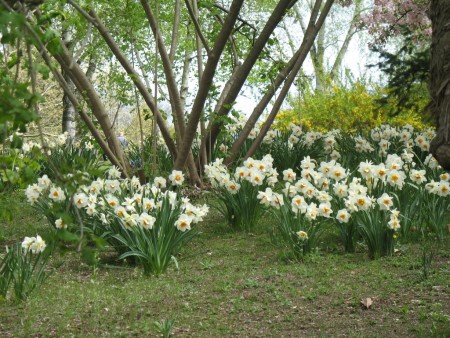
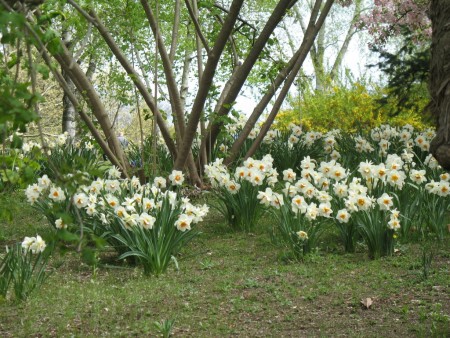
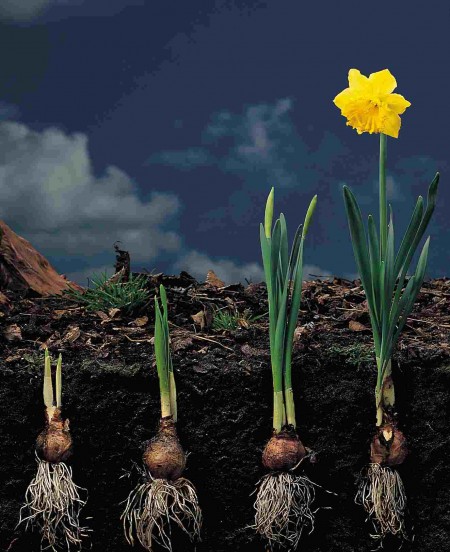
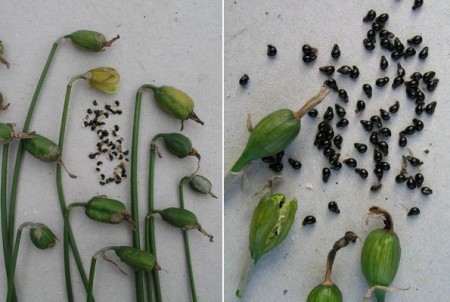
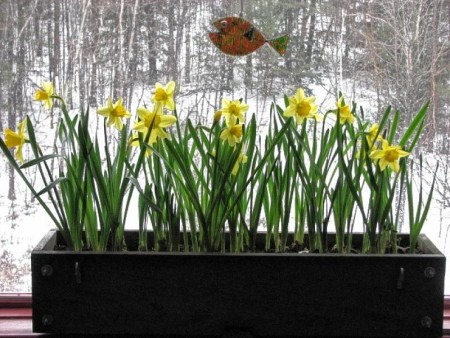
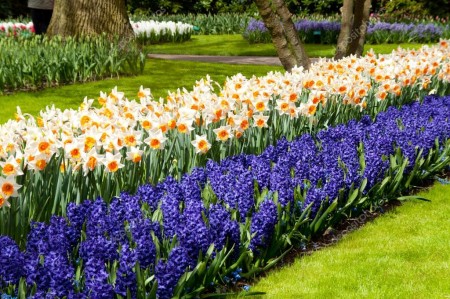
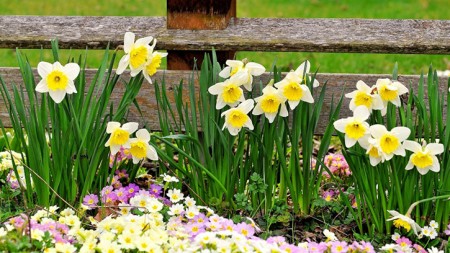

 (2 ratings, average: 4,50 out of 5)
(2 ratings, average: 4,50 out of 5) CUCUMBERS NEVER GET SICK, I'VE BEEN USING ONLY THIS FOR 40 YEARS! I SHARE A SECRET WITH YOU, CUCUMBERS ARE LIKE THE PICTURE!
CUCUMBERS NEVER GET SICK, I'VE BEEN USING ONLY THIS FOR 40 YEARS! I SHARE A SECRET WITH YOU, CUCUMBERS ARE LIKE THE PICTURE! You can dig a bucket of potatoes from each bush. Do you think these are fairy tales? Watch the video
You can dig a bucket of potatoes from each bush. Do you think these are fairy tales? Watch the video
 How our fellow gardeners work in Korea. There is a lot to learn and just fun to watch.
How our fellow gardeners work in Korea. There is a lot to learn and just fun to watch. Eye trainer. The author claims that with daily viewing, vision is restored. They don't charge money for views.
Eye trainer. The author claims that with daily viewing, vision is restored. They don't charge money for views. A 3-ingredient cake recipe in 30 minutes is better than Napoleon. Simple and very tasty.
A 3-ingredient cake recipe in 30 minutes is better than Napoleon. Simple and very tasty. Therapeutic exercises for cervical osteochondrosis. A complete set of exercises.
Therapeutic exercises for cervical osteochondrosis. A complete set of exercises. Which indoor plants match your zodiac sign?
Which indoor plants match your zodiac sign? What about them? Excursion to German dachas.
What about them? Excursion to German dachas.